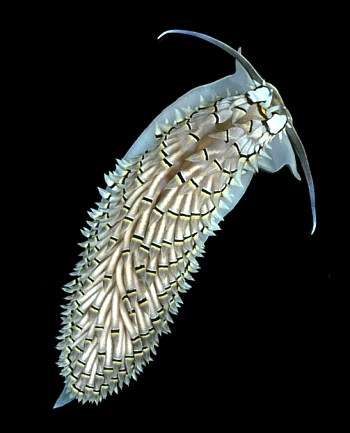
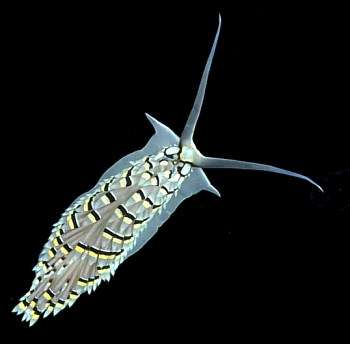
Cerberilla annulata
(Quoy & Gaimard, 1832)
Order: NUDIBRANCHIA
Suborder: AEOLIDINA
Family: Aeolidiidae
DISTRIBUTION
Wide Indo-West Pacific distribution.
PHOTO
UPPER: Adult, 62mm long. LOWER: Juvenile, 32mm long. Showing change in body proportions between juveniles and adults. Koumac Beach (=Baie de Ouanap), near Koumac, New Caledonia, 20°34'S, 164°16'E, Mixed soft and hard substrate, grassbeds, algae, October 1993. PHOTOS: Bill Rudman.
This sand dwelling aeolid has a wide tropical Indo-West Pacific distribution with published records from New Guinea (Quoy & Gaimard) and Tahiti (Bergh). I have found it in Zanzibar, Tanzania and New Caledonia. It is characterised by the relatively long cerata, white body and cerata, and yellow (upper) and black (lower) band near the ceratal tip.
Reference:
• Quoy, J.R. & Gaimard, J.P. (1832). Voyages de découvertes de l`Astrolabe pendant les annees 1826-1829 sous le commandement de M.J. Dumont d`Urville. Zoologie, 2: 1-686.
Rudman, W.B., 1999 (November 25) Cerberilla annulata (Quoy & Gaimard, 1832). [In] Sea Slug Forum. Australian Museum, Sydney. Available from http://www.seaslugforum.net/find/cerbannu
Related messages
Cerberilla annulata from Zanzibar, east Africa
March 2, 2005
From: Bill Rudman
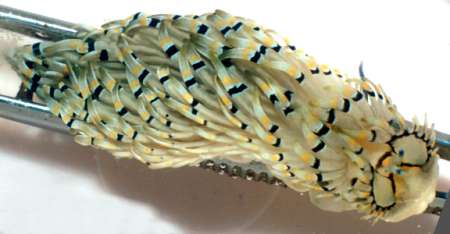
As promised in an earlier message [#13224] here is a record of Cerberilla annulata from Zanzibar, Tanzania. I found it half dead in a pool in muddy sand at lowtide. In the lower photos the long grey oral tentacles are folded down the side of the foot on each side. The specimen is propped up on a pair of forceps so I could photograph it properly, so don't be ashamed if your photo has a blemish, our aim is to get a record of the shape and colour, a perfect photo is a bonus, but not essential.
Locality: Mazzizini, Zanzibar, Tanzania, 9 July 1971. 45mm long alive. AM C145653. Photos: Bill Rudman
This is the first record of the species from East Africa.
Best wishes,
Bill Rudman


Cerberilla annulata from Red Sea
February 25, 2005
From: Binyamin Koretz

Hi Bill,
Looking at this 2003 photo of a slug which we had been unable to identify, it struck me now that it could be a species of Cerberilla. What do you think?
Locality: Eilat, Divers' Village, Israel, Red Sea. Depth: 6 m, Length: ca. 2 cm. October 2003. sandy flat with occasional corals. Photographer: Binyamin and Shulamit Koretz
Best regards,
Binyamin Koretz
binyamin@koretz.net
Koretz, B., 2005 (Feb 25) Cerberilla annulata from Red Sea. [Message in] Sea Slug Forum. Australian Museum, Sydney. Available from http://www.seaslugforum.net/find/13224Dear Binyamin,
This is indeed a Cerberilla, and most probably Cerberilla annulata. I don't think its been recorded from your part of the world, but I have found it in Zanzibar, East Africa. I should have a photo of it which I will post when I get a chance. Your animal is most probably a juvenile. When they are smaller, the head tentacles are proportionally much larger than when they are adults.
Best wishes,
Bill Rudman
Juvenile Cerberilla annulata from Lizard Id
January 10, 2004
From: Nils Anthes
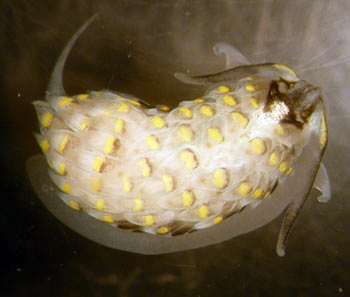
Dear Bill,
Here is a small pale Cerberilla which we think may be the same as the darker ones in our other message. It was found during November - December 2003 with the dark species on a sandy bottom in 2-5m depths at Lizard Island (QLD, Australia). Body length 7-10mm.
Regards
Nils
anthes@uni-muenster.de
Anthes, N., 2004 (Jan 10) Juvenile Cerberilla annulata from Lizard Id. [Message in] Sea Slug Forum. Australian Museum, Sydney. Available from http://www.seaslugforum.net/find/11850Thanks Nils,
I am pretty sure this is a juvenile of Cerberilla annulata. If you look at the phoptos on the Forum you will see the body proportions change quite considerably as the animal grows in size.
Best wishes
Bill Rudman
Re: Cerberilla from the Marshall Islands
March 25, 2001
From: Scott Johnson
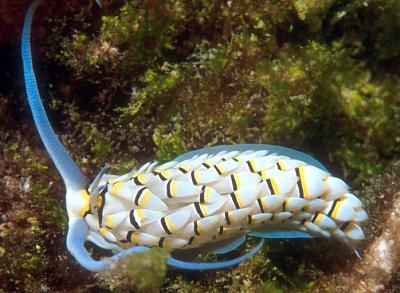
Hi Bill,
I finally came across another Cerberilla here in the Marshall Islands. I am assuming these are the same as the Cerberilla sp. 3 I sent a while back, although there are a couple of differences. It does not exhibit the black tips of the cephalic tentacles seen in the earlier specimens from Enewetak and Guam. The new specimen also has much more distinct yellow bands above the black ones on the cerata, providing a bit more evidence that it may be C. annulata. This specimen was found in Kwajalein's harbor, crawling on sand at a depth of about 1 meter. It measured about 20mm, a bit over half the length of the Cerberilla sp. 3 sent earlier.
Scott
johnson@.kmr.ll.mit.edu


Thanks Scott,
Thanks for the beautiful photos. It certainly looks like C. annulata and suggests that your earlier animal, which I called Cerberilla sp. 3 may have been a variant with very faded yellow markings. The black-tipped rhinophores and oral tentacles in Cerberilla sp. 3 are apparently variable because in Clay Carlson's message the Guam animal seems to lack black-tipped rhinophores. You are probably right in suggesting they are all colour forms of C. annulata but as I said earlier, it is easier to amalgamate them when we are sure, than separate them if we find they are indeed different.
I must say that the length of the oral tentacles shown in your photos are amazing. Considering the reduced size of the rhinophores, it suggests that using the oral tentacles for touch, is more important in locating prey than using the chemosensory abilities of the rhinophores.
Best wishes,
Bill Rudman
Cerberilla annulata & C. affinis
November 26, 1999
From: Bill Rudman
Here as promised are pages on Cerberilla affinis and Cerberilla annulata, two of the fascinating sand-dwelling aeolids.
Cheers,
Bill Rudman.
